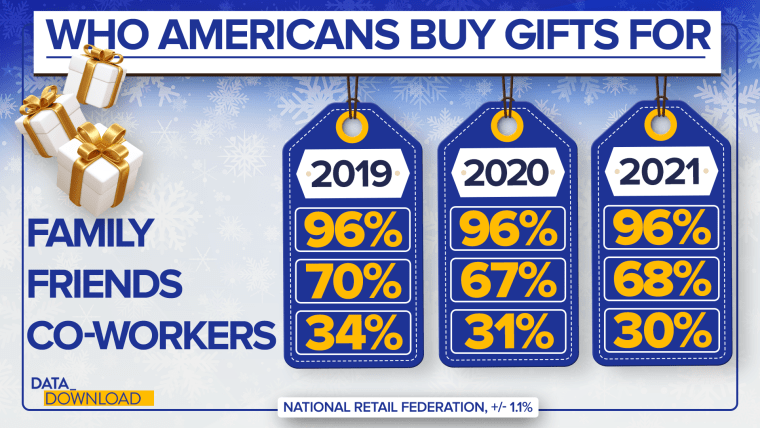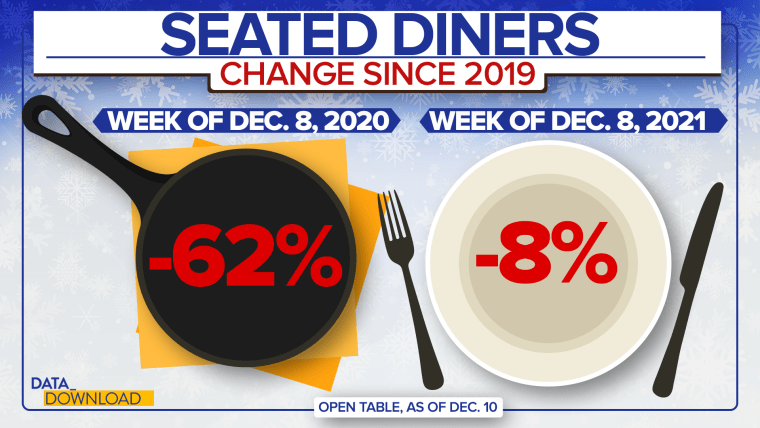WASHINGTON — This will be the second holiday season affected by the Covid-19 pandemic. But even as the coronavirus lingers, there are signs the season will be different from last year.
Back to normal? No. There’s a long list of reasons that’s not true — from masking to vaccination cards. But grumpy consumers aside, the data suggest that this year is going to look and feel a lot more like a pre-pandemic holiday than 2020.
Let's start with gift-giving. A new CNBC poll finds that planned gift spending is up this holiday season compared to last.

The poll shows that, on average, people plan to spend a little more than a $1,000 on gifts this year. That's about $120 more than they planned to spend last year and about $20 more than they planned to spend back in 2019.
That's a pretty big jump compared to 2020 — a 13 percent increase — and it should be noted that 78 percent of Americans in the same poll say the economy is only "fair" or "poor.”
The numbers suggest that other factors are affecting those feelings about the economy, a sense that whatever the gross domestic product or unemployment figures are (and both have been good of late), something is still not right.
One thing that may be on their minds is that many Americans are not fully back at work, and that could have some impact this holiday season, as well, particularly when it comes to gift-giving. A poll from the National Retail Federation suggests that our time "working from home" may be affecting our holiday shopping.

Almost everyone is buying gifts for family, 96 percent, according to the survey, which has held steady over the pandemic. Even when people weren't getting together over the holidays, it seems, they were shipping gifts to parents and children, nieces and nephews.
And the number of people buying gifts for friends is pretty stable, around 70 percent, down a bit (perhaps because of less frequent gatherings) but not far off.
But the co-worker number has dropped in the last few years. While co-workers have never been big gift recipients, 30 percent of people are buying gifts for officemates this year, down from 34 percent in 2019.
That may be a longer-term Covid difference, possibly because of changed work environments. Less time at the office means fewer office parties and fewer "secret Santas" or "white elephant" gift exchanges. And until people are back at the office regularly, whenever that is, it's hard to see how or why that number would climb.
But the biggest change this holiday season may be where people celebrate. The arrival of vaccines and sheer Covid exhaustion have pushed people back out into restaurants and bars. Data from Open Table show just how much the dining scene has improved in the last 12 months.

Last year at this time, the number of diners seated at restaurants — those with reservations or walk-ins — was down by 62 percent from 2019. That was a massive drop, and a lot of it was due to shuttered dining rooms. Even if the kitchens were working, a lot of the food was to go.
This year, the number is still down from 2019. But the drop is much smaller, only 8 percent. Again, a lot of that has to do with how many places are open this year compared to last, but that's the point. It suggests a Christmas more in line with pre-pandemic times.
That's the big theme in a lot of numbers this holiday season. Things aren’t "normal" in 2021, but they are closer to normal. And somewhere in there may be an important political message.
Considering how bad things were in the U.S. (and globally) last holiday season with Covid-19 — people unable to travel or gather, the economy staggering — things have come a long way.
But many polls find that Americans are still anxious and dissatisfied. And that might mean "a long way" isn’t enough to soothe a sour electorate as the country heads into an election year.